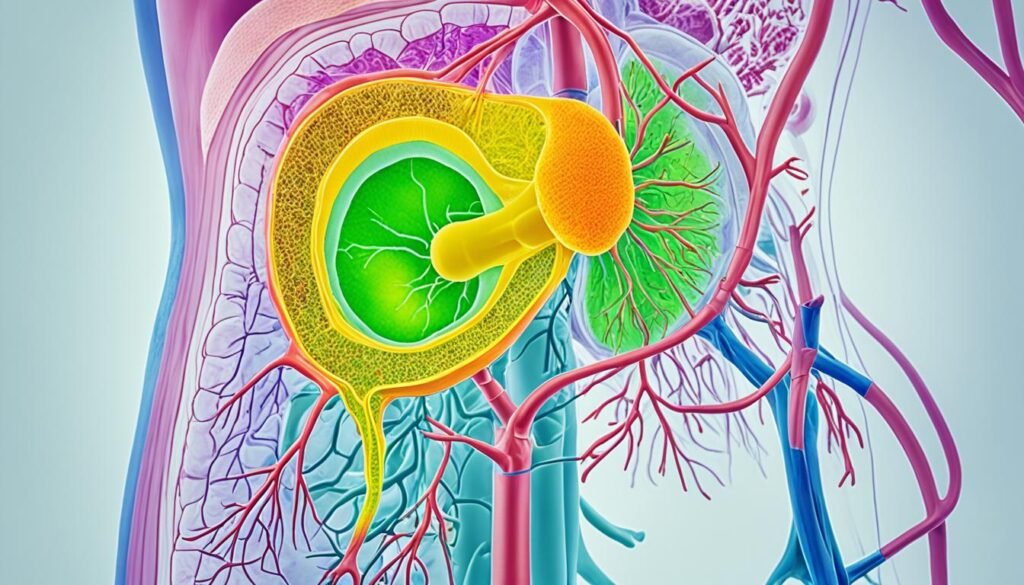If you’ve been experiencing symptoms like abdominal pain, fever, and nausea, you may be suffering from a condition called acalculous cholecystitis. But what exactly causes this condition? Let’s dive into the causes and risk factors associated with acalculous cholecystitis to help you understand it better.
Table of Contents
ToggleAcalculous cholecystitis is a disorder characterized by impaired gallbladder emptying, leading to inflammation and potential complications. While calculous cholecystitis is commonly caused by gallstones, acalculous cholecystitis occurs without the presence of gallstones. Instead, it is often triggered by other factors and underlying conditions.
Some of the risk factors for acalculous cholecystitis include long periods of fasting, total parenteral nutrition, drastic weight loss, and serious underlying conditions such as sepsis, trauma, burns, and major surgeries. These factors can contribute to gallbladder stasis and decreased function, known as hypokinetic biliary dyskinesia, increasing the risk of acalculous cholecystitis.
It’s important to note that chronic acalculous cholecystitis often has an unknown cause. It may develop gradually over time, making it difficult to pinpoint a specific trigger.
By understanding the causes and risk factors of acalculous cholecystitis, you can take proactive steps to reduce your risk and seek appropriate medical care if needed. Stay tuned for more information on the epidemiology, pathophysiology, diagnosis, and management of acalculous cholecystitis in the upcoming sections of this article.
Epidemiology of Acalculous Cholecystitis
Acalculous cholecystitis is a rare but significant condition, accounting for approximately 10% of all cases of acute cholecystitis and 5% to 10% of all cases of cholecystitis.
This condition affects both males and females equally; however, males are more likely to develop acute acalculous cholecystitis after surgery.
Immunosuppressed patients, such as those with HIV or undergoing bone marrow transplantation, are more prone to acalculous cholecystitis.
Epidemiological Factors
The mortality rate for acalculous cholecystitis varies between 30% and 50%, emphasizing the seriousness of this condition. Even those who survive may experience a long recovery period.
Now let’s take a closer look at the epidemiological factors associated with acalculous cholecystitis. The table below provides a comprehensive overview of the key statistics:
| Epidemiological Factors | Percentage |
|---|---|
| Prevalence in Acute Cholecystitis Cases | 10% |
| Prevalence in Cholecystitis Cases | 5% – 10% |
| Gender Distribution | Equal in males and females |
| Higher Risk in Males after Surgery | Higher in males |
| Prevalence in Immunosuppressed Patients | Higher in immunosuppressed patients |
| Mortality Rate | 30% – 50% |
| Long Recovery Period in Survivors | High |
As seen in the table, acalculous cholecystitis presents a significant morbidity and mortality burden. Prompt recognition and appropriate management of this condition are imperative to improve patient outcomes.
Pathophysiology of Acalculous Cholecystitis
Acalculous cholecystitis is a condition characterized by gallbladder stasis, leading to various pathological changes in the gallbladder wall. The pathophysiology of this condition involves multiple factors, including increased intraluminal pressure, ischemia, inflammation, and the potential development of gangrene and perforation.
Gallbladder stasis, which refers to the impaired emptying of the gallbladder, plays a crucial role in the pathogenesis of acalculous cholecystitis. When the gallbladder fails to empty properly, bile accumulates, causing increased intraluminal pressure. This elevated pressure compromises the blood supply to the gallbladder, leading to tissue ischemia.
In addition to gallbladder stasis and ischemia, inflammation also develops in the gallbladder wall. This inflammatory response is often triggered by bacterial colonization of the stagnant bile. The presence of bacteria activates the immune system, resulting in an inflammatory cascade that further damages the gallbladder tissue.
If left untreated, the combination of gallbladder stasis, ischemia, and inflammation can lead to severe complications. The gallbladder wall may become necrotic, and gangrene can develop, further compromising the integrity of the gallbladder. Eventually, the weakened gallbladder wall may perforate, causing bile leakage into the abdominal cavity.
It is important to note that the pathophysiology of chronic acalculous cholecystitis is similar to that of the acute form. However, chronic acalculous cholecystitis presents with intermittent and vague symptoms, making it more challenging to identify and diagnose.
| Pathophysiological Factors | Consequences |
|---|---|
| Gallbladder stasis | Increased intraluminal pressure |
| Ischemia | Tissue damage |
| Inflammation | Gallbladder wall inflammation |
| Bacterial colonization | Triggered immune response and further inflammation |
| Gangrene and perforation | Severe complications |
Understanding the pathophysiology of acalculous cholecystitis is crucial for the diagnosis and treatment of this condition. By targeting the underlying mechanisms of gallbladder stasis, ischemia, and inflammation, healthcare professionals can effectively manage acalculous cholecystitis and improve patient outcomes.
Diagnosis and Evaluation of Acalculous Cholecystitis
Diagnosing acalculous cholecystitis requires a thorough evaluation using various diagnostic tools. The primary methods used for diagnosis include a cholescintigraphy nuclear scan, ultrasound, and blood work.
HIDA Scan: A cholescintigraphy nuclear scan, also known as a HIDA scan, is commonly used to diagnose chronic acalculous cholecystitis. During this procedure, a radioactive tracer is injected into your body, which allows the doctor to track the flow of bile and identify any abnormalities. Cholecystokinin (CCK) administration may also be used during the scan to assess gallbladder function. If the calculated ejection fraction is 35% or less, it indicates hypokinetic gallbladder function, a characteristic of acalculous cholecystitis.
Ultrasound: An ultrasound is a widely available and non-invasive diagnostic tool used to evaluate acalculous cholecystitis. It provides detailed images of the gallbladder, allowing doctors to assess the thickness of the gallbladder wall. In the case of acute acalculous cholecystitis, an ultrasound of the abdomen is the preferred diagnostic method. It can reveal a thickened gallbladder wall with edema and possible fluid collection.
Blood Work: Blood tests are often conducted to support the diagnosis of acalculous cholecystitis. Elevated white blood cell count and abnormal liver function tests may indicate inflammation and infection of the gallbladder.
In some cases, a combination of imaging techniques and blood work may be necessary to confirm the diagnosis and rule out other conditions with similar symptoms.

Example image of a HIDA scan used for the diagnosis of acalculous cholecystitis.
Treatment and Management of Acalculous Cholecystitis
When it comes to the treatment and management of acalculous cholecystitis, the approach may vary depending on the patient’s condition. For unstable patients, it is important to focus on stabilization before any procedures can be performed. In such cases, percutaneous drainage or stent placement may be considered to decompress the gallbladder and relieve symptoms.
However, for patients with chronic acalculous cholecystitis, the gold standard treatment is a laparoscopic cholecystectomy. This minimally invasive procedure involves removal of the gallbladder using small incisions and a laparoscope. This approach offers several advantages including shorter hospital stays, faster recovery, and minimal scarring. In certain cases where an open procedure is necessary due to complications or other factors, an open cholecystectomy may be performed.
On the other hand, acute acalculous cholecystitis requires urgent treatment due to the potential risks and complications associated with the condition. In such cases, a cholecystectomy is the preferred treatment option. The aim is to remove the inflamed gallbladder to relieve symptoms and prevent further complications. It is important to note that antibiotics are usually ineffective in the treatment of acalculous cholecystitis due to compromised blood supply in the gallbladder.
Overall, timely and appropriate management is crucial in ensuring optimal outcomes for patients with acalculous cholecystitis. The choice of treatment depends on the patient’s stability, the chronicity of the condition, and the presence of any complications. By implementing effective surgical and therapeutic interventions, healthcare providers can significantly improve the prognosis and quality of life for individuals affected by this condition.

| Treatment Options | Advantages |
|---|---|
| Laparoscopic Cholecystectomy |
|
| Open Cholecystectomy |
|
Conclusion
Acalculous cholecystitis is a serious condition with significant morbidity and mortality rates. This condition, characterized by gallbladder stasis, inflammation, and potential complications like perforation and gangrene, can have severe consequences for patients. It is more prevalent in critically ill individuals and is often associated with multiple risk factors.
Diagnosis of acalculous cholecystitis is achieved through various imaging techniques and blood work. Prompt and accurate diagnosis is crucial for effective management and improved patient outcomes. Treatment typically involves stabilizing the patient before performing a cholecystectomy, a surgical procedure in which the gallbladder is removed.
To optimize patient care, it is essential to implement appropriate management strategies for acalculous cholecystitis. This includes early recognition of the condition, prompt initiation of diagnostic investigations, and timely intervention. Additionally, prioritizing patient stability and ensuring appropriate surgical techniques are employed are crucial for successful management.
In summary, acalculous cholecystitis is a complex condition that requires careful attention and swift action. By understanding the risk factors, recognizing the symptoms, and implementing effective management strategies, healthcare professionals can make a significant difference in the outcomes of patients with acalculous cholecystitis.
FAQ
What is acalculous cholecystitis?
Acalculous cholecystitis is a condition of gallbladder inflammation and decreased emptying that can occur without the presence of gallstones.
What are the risk factors for acalculous cholecystitis?
Risk factors for acalculous cholecystitis include long periods of fasting, total parenteral nutrition, drastic weight loss, and serious underlying conditions such as sepsis, trauma, burns, and major surgeries.
How prevalent is acalculous cholecystitis?
Acalculous cholecystitis accounts for approximately 10% of all cases of acute cholecystitis and 5% to 10% of all cases of cholecystitis.
What is the mortality rate for acalculous cholecystitis?
The mortality rate for acalculous cholecystitis ranges from 30% to 50%.
How is acalculous cholecystitis diagnosed?
The diagnosis of acalculous cholecystitis can be made using a cholescintigraphy nuclear scan (HIDA) with cholecystokinin (CCK) administration. An ultrasound may also be used to assess gallbladder wall thickness.
What is the treatment for acalculous cholecystitis?
Treatment for acalculous cholecystitis often involves stabilizing the patient before performing a cholecystectomy, either laparoscopic or open. Antibiotics are usually ineffective in treating acalculous cholecystitis.


